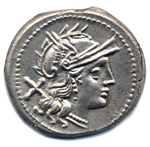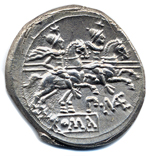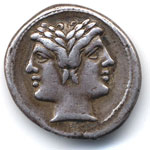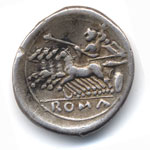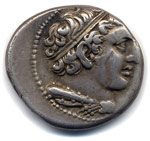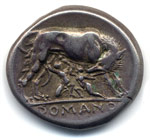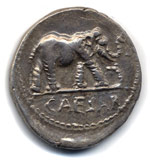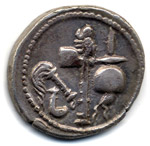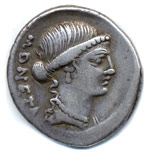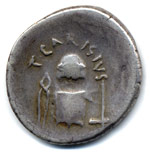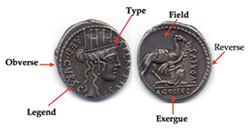Introduction to the Office of Moneyer in the Roman Republic
RRC 138/1
Obverse: Helmeted head of Roma right; behind, X. Border of dots.
Reverse: Dioscuri right; below P·; in linear frame, ROMA. Line border.
RRC 28/4
Obverse: Laureate, Janiform head of Dioscuri. Border of dots.
Reverse: Jupiter in quadriga left, driven by Victory – Jupiter hurls sceptre in left hand and hurls thunderbolt with right hand; incuse on tablet or in relief in linear frame, ROMA. Line border.
RRC 20/1
Obverse: Head of Hercules right (hair bound with ribbon),
with club and lionskin over shoulder. Border of dots.
Reverse: She wolf right, suckling twins; in exergue,
ROMANO.
RRC 443/1
Obverse: Elephant right, trampling dragon; in exergue,
CAESAR. Border of dots.
Reverse: Pontifical emblems – culullus, aspergillum,
axe and apex. Border of dots.
RRC 464/2
Obverse: Head of Juno Moneta right; behind, MONETA
downwards. Border of dots.
Reverse: Anvil die with garlanded punch die above;
on left, tongs; on right, hammer; above T·CARISIVS. Laurel-wreath as
border.
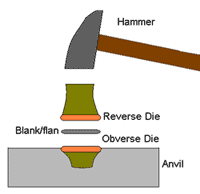
Coin striking
The responsibility of minting coins in Republican Rome was primarily that of the tresviri auro argento aere flando feriundo (“the three men for casting and striking of gold, silver and bronze” ), an official title often shortened to IIIviri monetales or AAAFF (after 44 BC the moneyers were increased to four and became known as the quattuorviri monetales, before Augustus reduced the number again to three). The office of tresviri was most likely established in the third century BC. This annual office was shared by three men; it was usually held at the beginning of one's career, often before a quaestorship. Candidates for the position normally had to be at least twenty-seven years of age, and had usually already served in the military.
Tresviri were responsible for coinage struck while they were in office. Consequently, they often placed their names on their coins, although anonymous issues did occur. In the early Republican Period signs and letters were used to identify the moneyer. Examples of these signs include a corn ear (RRC 40), an anchor (RRC 50) or a crescent (RRC 57).
Monograms (RRC 138/1) could also be used (the first listed in Crawford appears c. 210 BC - RRC 64/1-6). Abbreviations of the moneyers name could be placed on the coin (RRC 147 from 189-180 BC), or the monetales wrote out their names in full (e.g. RRC 149 in 189-180 BC). It must be stressed that this was not a linear development; symbols, monograms and fully written names were often used alongside each other, though symbols are most common in the early Republican period.
The types or images used on Roman Republican Coinage varied. Some were standard and stereotyped, particularly in the early Republican period, often displaying Jupiter in a quadriga or the Dioscuri. Other types alluded to the history of Rome and to the history of the moneyer's own family (e.g. RRC 149 in 189-80 BC) (Pink 1952). These differences in Roman Republican Coinage can be seen in three examples. RRC 28/4 (225-212 BC) is a standard type (Jupiter in a quadriga) with no allusion to the moneyer. RRC 20/1 (269-266 BC) makes an allusion to mythical Roman history: the story of Romulus and Remus. RRC 433/1, a coin of Brutus, gives his name in full (BRVTVS) and the type refers to the moneyers own family history. (See Libertas: The Coins of Brutus.)
From 80 BC. onwards men from more prominent families begin to hold the office of moneyer. Hamilton (1969) suggests that this was a result of the realisation of the propaganda value of coins. Many of the monetales took the opportunity to place on their coins designs that represented the achievements of their family and ancestors, thereby increasing their own prestige and hope of election to higher office. This is the traditional interpretation of many of the designs on Republican coinage. Recently it has been suggested that these representations should be seen in the context of a wider Roman cultural practice of honouring one's ancestors (Cheung 1998, Meadows/Williams 2001). Republican coins may not have been issued singularly for the purposes of propaganda, but as a commemoration or monumentum to the family to which the moneyer belonged.
Other officials could also strike coins if occasion demanded. Money could be issued by magistrates with senatorial approval or struck by imperatores (military commanders in the field) (e.g. RRC 483/2). Pompey and Caesar both struck coins during the civil wars (49 BC-48 BC) and Caesar struck his own coins while in Gaul, just prior to crossing the Rubicon (RRC 443/1).
Coins were struck by hand. The tools used for minting are shown on a coin (RRC 464/2) struck by the moneyer T. Carisius in 46 BC. On this coin we see an anvil die with the reverse die, tongs and hammer. The designs for the obverse and reverse of the coin would be engraved into hard metal. These designs are called dies. One die was placed in an anvil, and the other in a metal bar (the die placed in the metal bar was always the reverse of the coin). A pre-measured amount of metal (flan) would then be placed in between the two dies using a pair of tongs. A hammer would then be brought down on the reverse die, making an imprint on the metal.
Most of the coins displayed on this website are denarii, the standard coin of the Republic. This coin, introduced in 211-207 BC, weighed around 3.86g. (Crawford 1974:594)
There is specific terminology to describe a coin that any reader should be aware of.
- Type refers to the image on a coin
- Legend refers to the writing
- Exergue is a space on the coin below the central design, usually delineated by a line.
- The field of a coin is the blank space surrounding the image.
- The description of coins is also often abbreviated, l. meaning left and r. meaning right.
The seminal work in this area is that of M. Crawford, Roman Republican Coinage, (Cambridge, 1974). His references are used throughout this site (RRC) and those who are interested in a more detailed account are encouraged to consult his work along with the others listed in the bibliography. References to RPC refer to the Roman Provincial Coinage series.

